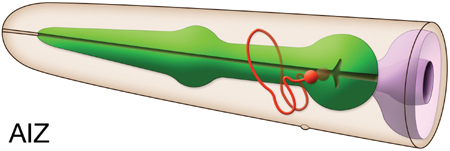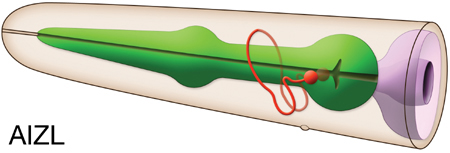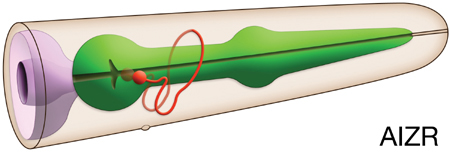
|
|
|
 
|
AIZL, AIZR
Type: Interneuron
In MoW: AIZ
In WormWiring:
AIZLh,
AIZRh,
AIZLm,
AIZRm
In Wormbase: AIZ, AIZL, AIZR
Lineage: AB plapaaapav, AB prapaaapav
Location: Lateral ganglia in the head
Description: Ring Interneurons. The process of each AIZ neuron travels through the amphid commissure to enter the ventral cord. From there, it travels anteriorly to enter the nerve ring. After running dorsally within the nerve ring, it meets its contralateral partner at the dorsal midline and makes a gap junction with it
Neurotransmitter/ Neuropeptide:
- Glutamate
- FLP-22; FMRFamide-like neuropeptide
(Loer, 2010; Li and Kim, 2008; Lee et al., 1999)
Innexin expression:
- INX-19
(Chuang et al., 2007)
Receptor expression:
- SER-2; tyramine receptor (expresses two separate splice variants)
(Altun, 2011; Tsalik et al., 2003)
|



|
Function: Integration of information from amphid sensory neurons; AIZL/R is one of the four (AIA, AIB, AIY, and AIZ) first-layer amphid interneuron pairs that receive and process synaptic output from the amphid sensory neurons towards a behavioral response. Along with the second-layer RIA and RIB interneurons, AIZ neurons also receive heavy input from the first layer AIA, AIB, AIY interneurons and they themselves send outputs to RIA and RIB. Additionally, AIZ synapse directly onto SMB head motor neurons.
- Functions in thermotaxis; Along with AIY and RIA, AIZ are thermotaxis core interneurons (Sasakura and Mori, 2012). Laser ablation of the AIZ pair makes the animals thermophilic. The thermal information sensed by AFD, AWC and ASI is processed in downstream interneurons AIY, AIZ, RIA, and also likely in AIA and AIB. In the original two-drive model of thermotaxis, activation of AIY neuron-signaling drives warm-seeking (thermophilic) movement, activation of AIZ neuron-signaling drives cold-seeking (cryophilic) movement, while the counterbalancing between the AIY and AIZ signals, possibly through the RIA interneuron, leads to execution of motor output in response to thermal signals. However, there is evidence that a thermophilic drive at temperatures below cultivation temperature (Tc) does not exist and regulation of thermotaxis involves a more complex circuit. Around Tc animals track isothermally on a gradient and above Tc they display negative thermotaxis by regulating their turning frequency and run duration. It has been suggested that thermosensory signals from AFD, AWC and ASI converge on the AIB interneuron in negative thermotaxis, whereas the AIY/AIZ/RIA network may function mainly in isothermal tracking (Ma and Shen, 2012; Sasakura and Mori, 2012; Ardiel and Rankin, 2011; Beverly et al, 2011; Ohnishi et al, 2011; Kuhara et al, 2008; Ryu and Samuel, 2002; Mori and Ohshima, 1995).
During associative learning between temperature and feeding state, starvation, a conditioning factor, downregulates AIZ activity through calcineurin/TAX-6, a calcium-activated phosphatase, leading to avoidance from Tc (Kuhara and Mori, 2006).
- Functions in locomotion: Laser ablation of AIZ, like AIB and AWC, causes decrease in reversals and leads to large increases in the duration of forward movement. Since ablations of AIY and AIZ cause opposite behavioral phenotpes, the synapses made by AIY onto AIZ may be inhibitory. Alternatively, signals fom AIY to AIZ could be processed in a downstream neuron such as RIA (Iino and Yoshida, 2009; de Bono and Maricq 2005; Tsalik and Hobert, 2003).
- Functions in chemotaxis: Laser ablation of AIZ causes defects in the weathervane (slow turning of the animal by biased head swing) and pirouette (bout of sharp turns generated by frequent reversals followed by omega turns) responses
(see Nervous System-General Description) leading to impaired chemotaxis (Iino and Yoshida, 2009). |
 Click pictures for higher resolution images Click pictures for higher resolution images
|
|
Click here for larger version
AIZL (AB plapaaapav) development in the embryo. Dorsal view. Bottom is left side of the embryo. Spheres indicate individual nuclei. Black sphere: ancestors of AIZL (since last AIZL ancestor has not yet gone through its final division, the black sphere seen at the end of this movie is still AB plapaaapa); dark grey spheres: apoptotic cells; other cells follow the WA color code (after they acquire specific cell or tissue identities). 0 min is fertilization. Click on the movie for higher resolution rendition (by A. Santella & Z. Bao). |
Click here for larger version
AIZR (AB prapaaapav) development in the embryo. Dorsal view. Bottom is left side of the embryo. Spheres indicate individual nuclei. Black sphere: ancestors of AIZR (since last AIZR ancestor has not yet gone through its final division, the black sphere seen at the end of this movie is still AB prapaaapa); dark grey spheres: apoptotic cells; other cells follow the WA color code (after they acquire specific cell or tissue identities). 0 min is fertilization. Click on the movie for higher resolution rendition (by A. Santella & Z. Bao). |

Last revision: November 20, 2012 |
|

